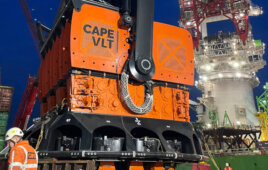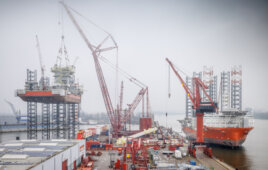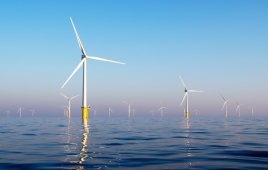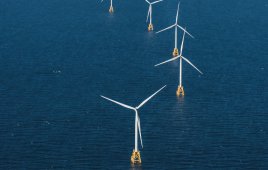Written by Adam Ferguson, Chief Technology Officer
FMC GlobalSat

Satellite connectivity lets wind owners and operators receive valuable data about how their assets are performing miles offshore, all while keeping their crews connected.
Offshore wind development comes with several logistics and construction challenges that are augmented in deeper waters further from shore. However, communication between the wind site and land is also a concern. Reliable connectivity is important for onsite technicians who may require information from personnel onshore.
It is also necessary for data transfer between turbines to an onshore control center.
To this end, a newer wind development off the shores of England is a guinea pig of sorts and serving as an important test site for a faster and more efficient way of implementing connectivity. The new satellite system connects those at the wind site to a reactive compensation station or RCS, which is located halfway between the shore and the wind farm.
Since its installation earlier this summer, the new satellite system has paid dividends for the RCS. The offshore crew reports 24/7 connectivity at the site location by using more than 4 GB of data with a bandwidth of 4Mbps download and 1Mbps upload daily. This also includes 100% uptime.
Looking back
Offshore wind developers typically relied on large, very high frequency or VHF antenna for site safety and personnel communications. Also, they installed a separate fiber-optic line to collect their SCADA data. More recently, developers have tried satellite systems, which require precise installation from a trained technician. These legacy systems have a large spatial profile and mechanical systems (for properly aligning and connecting to the satellite). They also require a great deal of maintenance for consistent uptime.

Satellite technology has advanced to the point where renewable energy owners and operators can increase their Internet connectivity and data usage while minimizing unplanned outages and maintenance costs.
Unfortunately, harsh offshore conditions often prove problematic for reliable communication systems. Strong winds and salt spray may blow an antenna out of alignment or introduce corrosion to the mechanically steered dish of a satellite. If this occurs, a highly skilled technician must repair the system. This means arranging travel time and an available crew vessel (sometimes easier said than done), which may quickly add to the O&M costs.
What’s more is that when connectivity is down, the utility off-taker may lose visibility on the asset, raising data reliability and safety concerns. Frequent or unexpected signal loss may interfere with the accuracy of asset monitoring and data accessibility. Historically, data issues caused by environmental conditions, such as rain fade, are the result of significant latency and packet loss. Packet loss occurs when one or more groups of data traveling across a network fail to reach their destination.
It typically results in slower than normal satellite transmit speeds, which then cause receiving terminals to time out and lose valuable information.
However, a new flat-panel satellite antenna (or electronically steered antenna) installed at the new European offshore wind site eliminates the need for external infrastructure. The antenna is connected via software (instead of a phased or electronically scanned array), locking onto a satellite in seconds. The technology has the fewest parts of antenna, is more reliable than a phased array antenna, and can withstand harsh marine environments.
The system also comes with a standard high bandwidth rate unaffected by throttling or slower service speeds. High-speed access means it is possible for wind operators to monitor assets via live video feeds and obtain real-time data and analytics, which can be used to improve efficiency, control environmental impacts, and enhance safety.
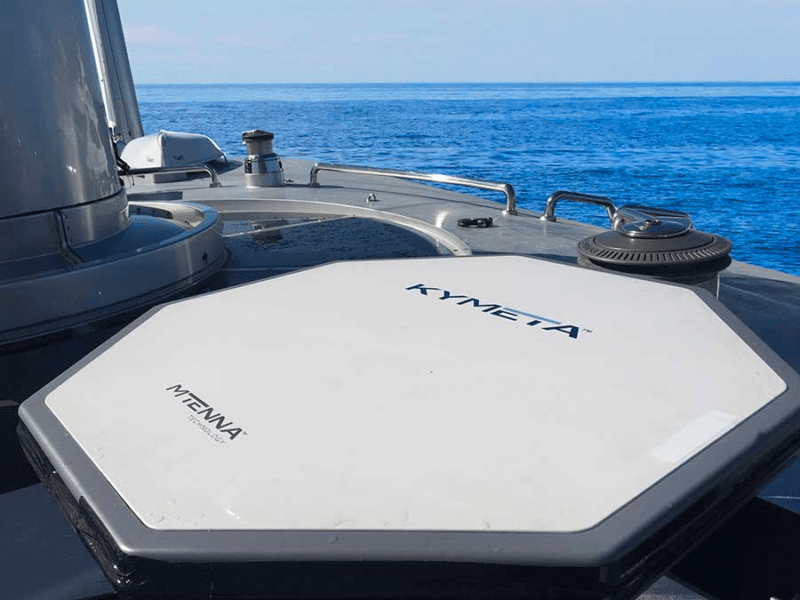
Kymeta’s flat-panel satellite antenna has solved some of the satellite industry’s longest standing technical challenges: the need for lightweight, slim, reliable communication systems that work in remote locations — such as offshore wind sites.
Looking ahead
The flat-panel satellite antenna is expected to handle the upcoming changes to the satellite industry. For example, while current satellite technology relies on geostationary earth orbit (GEO) satellites, several low-earth orbit (LEO) satellite constellations are expected to come online soon. These new constellations will offer higher performance and significantly lower latency than their GEO predecessors.
Unlike GEOs, LEOs will move from horizon to horizon in mere minutes, requiring new terminals to track the fast-moving satellites. Terminals will also need instantaneous switching capabilities to ensure uninterrupted connectivity. As the satellite that the terminal is linked with moves out of view, the terminal will need to form a new beam to catch the next satellite that comes into view.
This switch from disappearing satellite to appearing satellite will need to happen within milliseconds to avoid dropped connections and service interruptions.
Filed Under: News, Offshore wind

